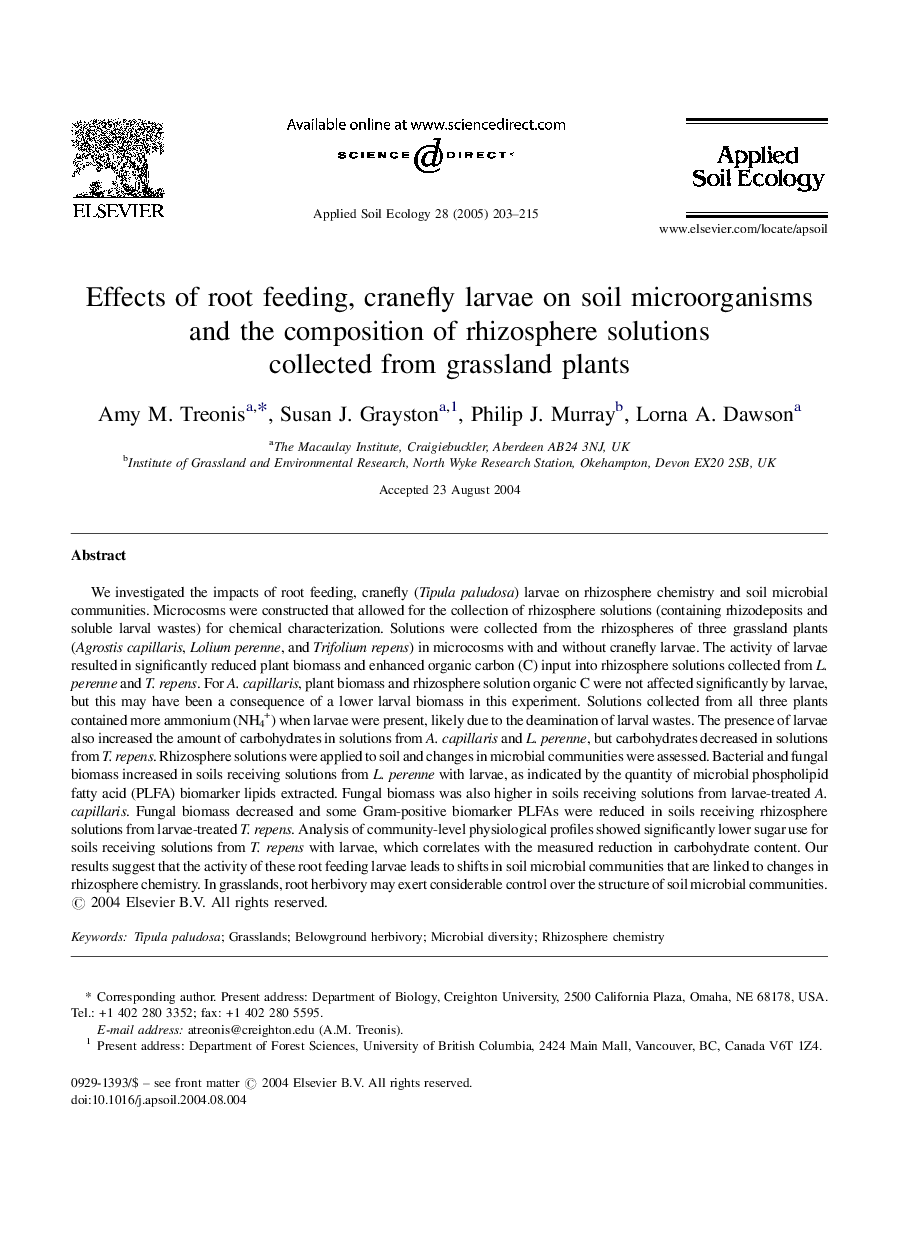| کد مقاله | کد نشریه | سال انتشار | مقاله انگلیسی | نسخه تمام متن |
|---|---|---|---|---|
| 9445250 | 1304282 | 2005 | 13 صفحه PDF | دانلود رایگان |
عنوان انگلیسی مقاله ISI
Effects of root feeding, cranefly larvae on soil microorganisms and the composition of rhizosphere solutions collected from grassland plants
دانلود مقاله + سفارش ترجمه
دانلود مقاله ISI انگلیسی
رایگان برای ایرانیان
کلمات کلیدی
موضوعات مرتبط
علوم زیستی و بیوفناوری
علوم کشاورزی و بیولوژیک
بوم شناسی، تکامل، رفتار و سامانه شناسی
پیش نمایش صفحه اول مقاله

چکیده انگلیسی
We investigated the impacts of root feeding, cranefly (Tipula paludosa) larvae on rhizosphere chemistry and soil microbial communities. Microcosms were constructed that allowed for the collection of rhizosphere solutions (containing rhizodeposits and soluble larval wastes) for chemical characterization. Solutions were collected from the rhizospheres of three grassland plants (Agrostis capillaris, Lolium perenne, and Trifolium repens) in microcosms with and without cranefly larvae. The activity of larvae resulted in significantly reduced plant biomass and enhanced organic carbon (C) input into rhizosphere solutions collected from L. perenne and T. repens. For A. capillaris, plant biomass and rhizosphere solution organic C were not affected significantly by larvae, but this may have been a consequence of a lower larval biomass in this experiment. Solutions collected from all three plants contained more ammonium (NH4+) when larvae were present, likely due to the deamination of larval wastes. The presence of larvae also increased the amount of carbohydrates in solutions from A. capillaris and L. perenne, but carbohydrates decreased in solutions from T. repens. Rhizosphere solutions were applied to soil and changes in microbial communities were assessed. Bacterial and fungal biomass increased in soils receiving solutions from L. perenne with larvae, as indicated by the quantity of microbial phospholipid fatty acid (PLFA) biomarker lipids extracted. Fungal biomass was also higher in soils receiving solutions from larvae-treated A. capillaris. Fungal biomass decreased and some Gram-positive biomarker PLFAs were reduced in soils receiving rhizosphere solutions from larvae-treated T. repens. Analysis of community-level physiological profiles showed significantly lower sugar use for soils receiving solutions from T. repens with larvae, which correlates with the measured reduction in carbohydrate content. Our results suggest that the activity of these root feeding larvae leads to shifts in soil microbial communities that are linked to changes in rhizosphere chemistry. In grasslands, root herbivory may exert considerable control over the structure of soil microbial communities.
ناشر
Database: Elsevier - ScienceDirect (ساینس دایرکت)
Journal: Applied Soil Ecology - Volume 28, Issue 3, March 2005, Pages 203-215
Journal: Applied Soil Ecology - Volume 28, Issue 3, March 2005, Pages 203-215
نویسندگان
Amy M. Treonis, Susan J. Grayston, Philip J. Murray, Lorna A. Dawson,